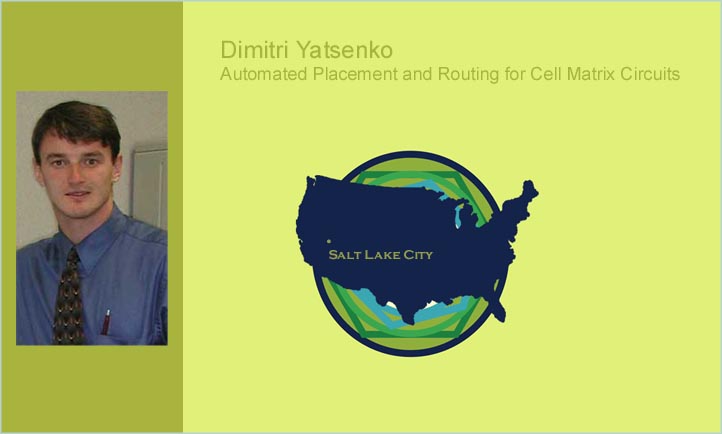
Dimitri Yatsenko wears several hats. He holds a job as a Systems Engineer at GE Medical Systems in Salt Lake City, Utah. He is also a graduate student at two universities. At Utah State University in Logan, Dimitri is currently finishing up a Master's degree in Computer Science. This past fall he began coursework toward a second Master's degree, in Computational Engineering and Science, at the University of Utah, in Salt Lake City. He is also passionate about hang gliding, and goes gliding every opportunity he gets.
Dimitri's first exposure to the Cell Matrix architecture was in 2000, when Cell Matrix Corporation Director Nicholas Macias talked about Cell Matrices at Utah State University, in a seminar given by Dr. Prof. Hugo de Garis. "I was learning about emergence and self-organizing systems at the time I heard about Cell Matrix," says Dimitri. "The configurability of the Cell Matrix platform seemed to have the potential to accommodate the dynamics of self-organizing systems in a natural and straightforward manner." His interest in the architecture eventually led to his thesis topic, which was to create the first netlist compiler for the Cell Matrix architecture. This provides a necessary link so that conventional circuit design tools, such as hardware definition languages and graphical schematic entry systems, can be used with Cell Matrix hardware as the hardware target.
"What Dimitri is doing has the potential to eliminate some of the steps we currently take to construct a Cell Matrix circuit," says Lisa Durbeck, who is a Director of Cell Matrix Corporation and a member of Dimitri's thesis committee.
"Every subcircuit in a Cell Matrix component library was laid out by hand. This is overkill in many cases, because for many, the internal layout of the component is not important, so long as it is reasonably efficient in its use of cells. With something like what Dimitri has devised, when we want to construct a new component, we should be able to describe the circuit in Verilog, specify where we want the inputs and outputs to go on the edge of the component, generate the component automatically, and then bring it into the Cell Matrix Simulator™ for verification and debugging. The design, implement, debug cycle would thus be heavier on the design and debug, which are usually the parts where human intervention is important."
"I believe that Cell Matrix layout process can be effectively fully automated," says Dimitri. For his thesis he surveyed the current literature in placement and routing research and then tried several methods for achieving placement of circuits comprised of simple one-cell library components onto a grid of 4-sided Cell Matrix cells. The starting point is a netlist, which is output that could be generated from a schematic entry tool such as Cadence's Orcad Capture, or from a description of a circuit in a hardware definition language such as Verilog. The output of Dimitri's compiler is a translation of the netlist specification to a Cell Matrix circuit specification, i.e., a complete definition of the truth table contents for a set of 4-sided Cell Matrix cells.
Dimitri's compiler uses a neural network to drive the search for a correct and reasonably efficient layout of the desired circuit. The neural net Dimitri implemented tries to minimize the length of the wires and the overall footprint of the layout. For instance, if two functions can be completed by one cell, the algorithm can combine the truth tables for both functions into one truth table. It can also change the orientation of the circuit component so that everything packs better.
Once Dimitri's thesis is complete, it will be accessible from this page and from our publications list.
Dimitri has not settled on a thesis topic yet for his second Master's degree in Computational Engineering and Science, but he is looking for something in image analysis and understanding, an area where he can combine his academic and professional interests. Self-organizing systems, and applications for them, continues to interest him greatly, and he believes that, in the near term future, this could be an important research focus within computational science. Meanwhile, he has been keeping abreast of Cell Matrix research and development, and he says that he finds Cell Matrices' "potential abilities and applications fascinating. I see the strengths of the Cell Matrix to be in machine learning, self-organizing and evolvable systems. In medical imaging, which has been at the center of my professional activity for the past two years, these concepts are not yet practical since predictability is key." However, while drinking Russian tea one evening with Nicholas Macias, Dimitri postulated uses in image analysis for decentralized, parallel operators on Cell Matrix hardware.

|
other people . publications . core . exit |